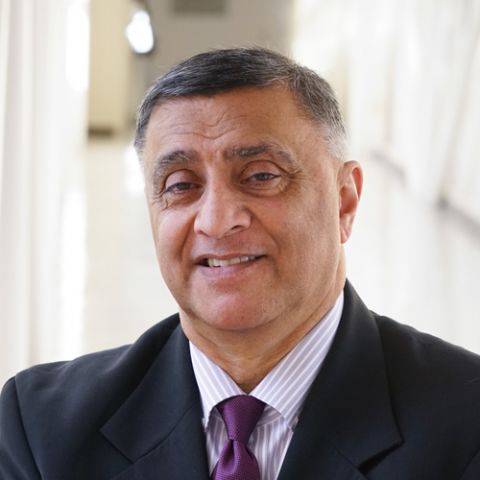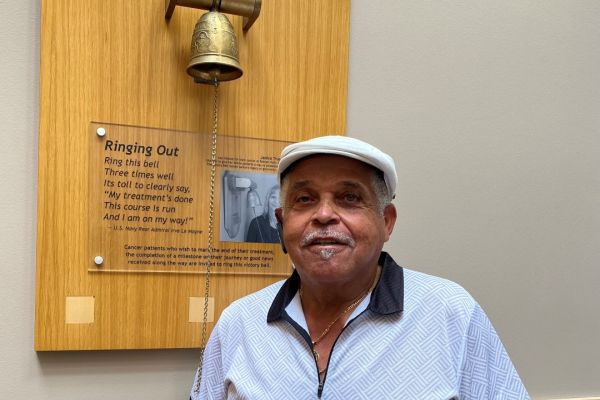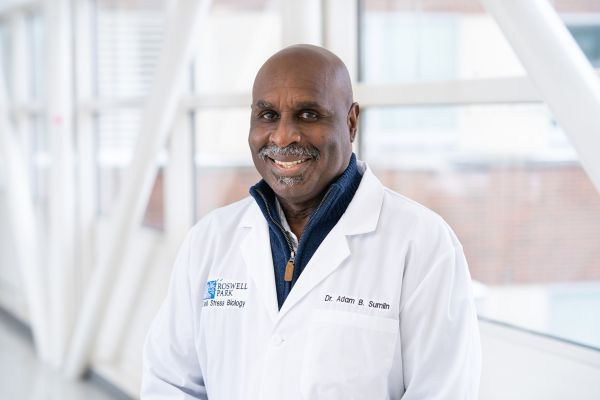Thanks to early detection efforts, most cases of prostate cancer are diagnosed at an early stage, when the cancer is confined to the prostate. Some men have their prostate cancer diagnosed after it has spread to nearby lymph nodes. Still, for both these groups, treatment is very effective and five-year survival is close to 100%.
Currently, about 5-7% of men with prostate cancer have metastatic disease at the time of diagnosis. In these men, the cancer has already spread to the lymph nodes and/or bone. Rarely, the cancer may also spread to other organs in the body, such as the lung or liver. Additionally, some men develop advanced-stage or metastatic cancer after treatment for an early-stage cancer. “If initial treatment is begun right away, we can cure over 60% of men with prostate cancer. That means, despite our best efforts, about a third of men with prostate cancer will relapse and go onto develop metastatic disease,” says medical oncologist Gurkamal Chatta, MD, Chief of Genitourinary Oncology at Roswell Park Comprehensive Cancer Center.
Fortunately, new treatments have evolved that can mitigate the disease’s progression, reduce its symptoms and add years of life to the patient.
How prostate cancer spreads
Prostate cancer that is considered high risk or more aggressive is more likely to have cancer cells that escape the tumor in the prostate and spread to nearby tissue. They usually spread to the nearby lymph nodes first. Once there, they can be dormant for years, and subsequently spread through the bloodstream or lymph vessels to other parts of the body. Most cancers have a predilection for certain body parts over others. “The striking thing about prostate cancer, as opposed to other cancers, is it eventually winds up in bone,” says Dr. Chatta. According to the Prostate Cancer Foundation, about 85% to 90% of prostate cancer metastases are to bone.
Prostate cancer can also travel to the lungs, liver, brain or other organs, but the lymph nodes and bone are the primary locations. “That’s something we don’t quite understand, but it probably has to do with certain proteins prostate cancers make, which then direct it to the bone,” he says. Prostate cancer may metastasize even after the prostate is removed surgically, especially in the more aggressive forms of the cancer. “If you have a high-risk cancer, it has a greater propensity to spread. You could have some cells outside the surgical field that we can’t detect with current imaging techniques,” Dr. Chatta says.
Detecting prostate cancer progression
However, recent advances in imaging technology have given doctors better tools to find those stray cancer cells. “We now have more sophisticated scans to pick these up before surgery, which only became available in the last 12 to 15 months,” he says. “Only time will tell if these will increase cure rates.”
Men who have been diagnosed with prostate cancer undergo certain tests to see if the cancer has spread, including X-rays and CT, MRI and prostate-specific PET scans. Patients have these tests periodically in the years after initial treatment to keep tabs on the disease.
Symptoms such as bone pain and broken bones may also signify cancer spread. If prostate cancer patients experience those, they should alert their doctor, who may order the appropriate scans. However, the goal of newer imaging techniques is to pick up the cancer well before any symptoms develop.
Treating metastatic prostate cancer
Find out everything you need to know about metastatic prostate cancer.
Learn moreTreating advanced prostate cancer
It is very important for patients with advanced prostate cancer to seek care from a comprehensive cancer center like Roswell Park, Dr. Chatta says. “The single biggest thing is, we have a whole team of people attacking this problem, which is clearly beyond the bandwidth of one or two people. When you have a whole team, that makes for better care.”
Treatment for advanced prostate cancer may include a number of different approaches, including hormone therapy, chemotherapy, immunotherapy, radiopharmaceuticals and targeted therapy. However, the mainstay of treatment continues to be hormone therapy, which aims to block interactions between androgens (testosterone) and the androgen receptor on cells. “At any given stage, whether it has spread to lymph nodes or bone, the bread and butter of prostate cancer treatment is to knock down testosterone,” Dr. Chatta says. “It is the main fuel for prostate cancer.”
Over the past 10 to 15 years, researchers have developed numerous strategies for “knocking down testosterone,” he adds. “In the past, that meant removing the testes, which are the body’s primary source of testosterone. Over the years we have figured out chemical ways to do that. The net result is the same. We have also learned that although testes produce greater than 95% of testosterone, other sources are equally relevant, such as the adrenal glands. We have learned how to block those as well. The one other source of testosterone we have learned to appreciate is the cancer itself. Prostate cancer cells (wherever they are) can make their own testosterone and feed themselves.”
New treatment advances
Newly developed hormone drugs can interrupt the interaction between testosterone and the receptor it binds to on the cancer cell. “The receptor becomes super-sensitive and, in turn, becomes sensitive to very small amounts of testosterone. The newer drugs that block these interactions are referred to as novel hormonal therapies or second-generation androgen deprivation therapy. That’s where the main advances have been in the last 12 to 15 years,” he says.
Dr. Chatta stresses that this is hormone therapy, not chemotherapy, but there are still unpleasant side effects. The drugs cause a very severe form of andropause, the male equivalent of menopause. Side effects can include hot flashes, erectile dysfunction, weight gain, mood swings, and elevated blood pressure, cholesterol and blood sugar. “Very often the toll all this takes on one’s quality of life is underappreciated. Managing these side effects and quality of life for people living with prostate cancer is a huge area of emphasis for the team at Roswell Park, and another reason to seek care at a comprehensive cancer center.”
In addition to hormone therapy, there have also been advances in other spheres of advanced prostate cancer care. Thus, there are two chemotherapy drugs (Docetaxel and Cabazitaxel), which can prolong life. “With the help of genetic testing, we can identify subsets of patients, who respond very well to immunotherapy (3 to 5%) and other specific targeted therapies like PARP inhibitors (10 to 15%). In the last year, we also have approved radiopharmaceuticals (Pluvicto), for refractory advanced disease and being actively tested in earlier settings."
Finally, ongoing clinical trials based on scientific work done at Roswell Park with cancer researchers Dean Tang, PhD, and David Goodrich, PhD, Department of Pharmacology and Therapeutics, are assessing novel ways of targeting the androgen receptor. “Every patient with advanced prostate cancer really requires a personalized approach beyond hormone therapy. This is best achieved by a team of scientists and providers at a comprehensive cancer center,” says Dr. Chatta.
Once prostate cancer has spread beyond regional lymph nodes to bone or other areas, the focus is on cancer control rather than cure, explains Dr. Chatta. “Compared to something like advanced lung cancer, where survival is limited, people can live with advanced prostate cancer for a long time — five years and more.”





